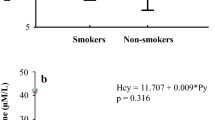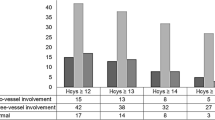Summary
Total serum homocysteine and cholesterol levels were determined in 163 male patients with typical angina who were subjected to coronary angiography. The prevalence of homocysteinemia in coronary heart disease (CHD) was 41.9%. Serum homocysteine levels were significantly elevated (p<0.05) in patients with major occlusion in two or three coronary arteries. Furthermore, the prevalence of homocysteinemia correlated positively (p<0.05) with the number of coronary vessels that were occluded. The prevalence of hypercholesterolemia was 34.9%, but, in contrast to homocysteinemia, no graded strength of association with the number of stenotic coronary arteries could be demonstrated. The results suggest that homocysteinemia may contribute significantly to the development of coronary heart disease.
Similar content being viewed by others
Abbreviations
- CHD:
-
coronary heart disease
- HPLC:
-
highperformance liquid chromatography
- MTHF:
-
methylenetetrahydrofolate
- SD:
-
standard deviation
- SBD-F:
-
ammonium 7-fluoro 2-oxa-1,3 diazole-4-sulphonate
- TC:
-
total cholesterol
References
Araki A, Sako Y (1987) Determination of free and total homocysteine in human plasma by HPLC with fluorescence detection. J Chromatogr 422:43–52
Brattström L, Israelsson B, Lingärde F, Hultberg B (1988) Higher total plasma homocysteine in vitamin B-12 deficiency than in heterozygosity for homocysteinuria due to cystathionine β-synthase deficiency. Metabolism 37:175–178
Brattström L, Israelsson B, Tengborn L, Hultberg B (1989) Homocysteine, factor VII and antithrombin III in subjects with different gene dosage for cystathionineβ synthase. J Inher Metab Dis 12:475–482
Brattström L, Israelsson B, Norrving B, Bergqvist D, Thörne J, Hultberg B, Hamfelt A (1990) Impaired homocysteine metabolism in early-onset cerebral and peripheral occlusive arterial disease. Atherosclerosis 81:51–60
Brown MS, Goldstein JL (1990) Scavenging for receptors. Nature 343:508–509
Chadefaux B, Ceballos I, Hamet M, Coude M, Poissonnier M, Kamoun P, Allard D (1988) Is absence of atheroma in Down syndrome due to decreased homocysteine levels? Lancet II:741
Cochran WG (1954) Some methods for strengthening the common chi-square tests. Biometrics 10:417–441
Editorial (1984) Progress in coronary artery disease riskfactor research: what remains to be done? Clin Chem 30:1125–1127
Freedman D, Popio K, Kredich N, Heiss G (1982) Plasma homocysteine and coronary artery disease (abstract). Am J Epidemiol 116:566
Genest JJ, McNamare JR, Salem DN, Wilson PW, Schaefer EJ, Malinow MR (1990) Plasma homocyst(e)ine levels in men with premature coronary artery disease. J Am Coll Cardiol 16:1114–1119
Gibson JB, Carson NAJ, Neill DW (1964) Pathological findings in homocystinuria. J Clin Pathol 17:427–437
Harker LA, Ross R, Slichter SJ, Scott CR (1976) Homocys-teine-induced arteriosclerosis. The role of endothelial cell injury and platelet response in its genesis. J Clin Invest 58:731–741
Hopkins PN, Williams RR (1981) A survey of 246 suggested risk factors. Atherosclerosis 40:1–52
Israelsson B, Brattström LE, Hultberg BL (1988) Homocysteine and myocardial infarction. Atherosclerosis 71:227–233
Kang S, Wong PWK, Cook HY, Norusis M, Messer JV (1986) Protein-bound homocysteine. A possible risk factor for coronary artery disease. J Clin Invest 77:1482–1486
Kang S, Wong PWK, Norusis M (1987) Homocysteinemia due to folate deficiency. Metabolism 36:458–462
Kang S, Wong PWK, Zhou J, Sora J, Lessick M, Ruggie N, Grcevich G (1988) Thermolabile methylenetetrahydrofolate reductase in patients with coronary artery disease. Metabolism 37:611–613
Kang S, Zhou J, Wong PWK, Kowalisyn J, Strokosch G (1988) Intermediate homocysteinemia: a thermolabile variant of methylenetetrahydrofolate reductase. Am J Hum Genet 43:414–421
Kodoma T, Freeman M, Rohrer L, Zabrecky J, Matsudaira P, Kruger M (1990) Type 1 macrophage scavenger recepor contains α-helical and collagen-like coiled coils. Nature 343:531–535
Levene H (1960) Robust tests for equality of variance. In: Olkin I (ed) Contributions to probability and statistics. Stanford University Press, Palo Alto, pp 278–292
Lie RF, Schmitz JM, Fierre KJ (1976) Cholesterol oxidase based determination by continuous-flow analysis of total and free cholesterol in serum. Clin Chem 22:1627–1629
Lin J, Kang S, Zhou J, Wong PWK (1988) Homocysteinemia in rats induced by folic acid deficiency. Life Sci 44:319–325
Malinow MR (1990) Hyperhomocysteinemia. A common and easily reversible risk factor for occlusive atherosclerosis. Circulation 81:2004–2006
McCully KS (1969) Vascular pathology of homocysteinemia: implications for the pathogenesis of arteriosclerosis. Am J Pathol 56:111–128
McCully KS (1983) Homocysteine theory of atherosclerosis: development and current status. Atherosclerosis Rev 11:157–246
McDonald L, Bray C, Field C, Love F, Davies B (1964) Homocystinuria, thrombosis and the blood platelets. Lancet I:745–746
Mudd SH, Levy HL, Skovby F (1989) Disorders of transsulfuration. In: Scriver R, Beaudet AL, Sly WS, Valle D (eds) The metabolic basis of inherited disease, 6th edn. McGraw-Hill, New York, pp 693–734
Murdoch JC, Rodger JC, Rao SS, Fletcher CD, Dunnigan MG (1977) Down's syndrome: an atheroma free model? BMJ II:226–228
Murphy-Chutorian DR, Wexman MP, Grieco AJ, Heiniger JA, Glassman E, Gaull GE, Feit F, Wexman K, Fox AC (1985) Methionine intolerance: a possible risk factor for coronary artery disease. J Am Coll Cardiol 6:725–730
Nieuwenhuizen EFJ (1984) Second Carnegie Inquiry into poverty and development in Southern Africa. Cape Town University Press, Cape Town
Olson RE (1989) A critique of the report of the National Institutes of Health expert panel on detection, evaluation, and treatment of high blood cholesterol. Arch Intern Med 149:1501–1503
Parthasarathy S (1987) Oxidation of low-density lipoproteins by thiol compounds leads to its recognition by the acetyl LDL receptor. Biochim Biophys Acta 917:337–340
Ratnoff OD (1968) Activation of Hageman factor by L-homocystine. Science 162:1007–1009
Rodgers WH, Kane GM (1986) Activation of endogenous factor V by a homocysteine-induced vascular endothelial cell activator. J Clin Invest 77:1909–1916
Sartorio R, Carrozzo B, Corbo L, Andria G (1986) Proteinbound plasma homocysteine and identification of heterozygotes for cystathionine-synthase deficiency. J Inher Metab Dis 9:25–29
Starkebaum G, Harlan JM (1986) Endothelial cell injury due to copper catalyzed hydroxide-peroxide generation from homocysteine. J Clin Invest 77:1370–1376
Stipanuk M (1986) Metabolism of Sulfur-containing amino acids. Ann Rev Nutr 6:179–209
Ubbink JB, Serfontein WJ, De Villiers LS (1985) Stability of pyridoxal-5-phosphate semicarbazone: application in plasma vitamin B-6 analysis and population surveys of vitamin B-6 nutritional status. J Chromatogr 342:277–284
Ubbink JB, Vermaak WJH, Bissbort S (1991) Rapid highperformance liquid chromatography assay for total homocysteine levels in human serum. J Chromatogr 565:441–446
Ueland MP, Refsum H (1989) Plasma homocysteine, a risk factor for vascular disease: plasma levels in health, disease, and drug therapy. J Lab Clin Med 114:473–501
Wilcken DEL, Dudman NPB, Tyrell PA, Robertson MR (1988) Folic acid lowers elevated plasma homocysteine in chronic renal insufficiency: possible implications for prevention of vascular disease. Metabolism 37:697–701
Wyndham CH (1983) Trends in age-specific mortality rates for ischaemic heart disease, 1968–1977. S Afr Med J 64:13–15
Author information
Authors and Affiliations
Rights and permissions
About this article
Cite this article
Ubbink, J.B., Vermaak, W.J.H., Bennett, J.M. et al. The prevalence of homocysteinemia and hypercholesterolemia in angiographically defined coronary heart disease. Klin Wochenschr 69, 527–534 (1991). https://doi.org/10.1007/BF01649290
Received:
Revised:
Accepted:
Issue Date:
DOI: https://doi.org/10.1007/BF01649290




